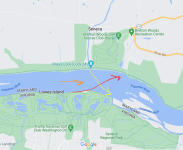Normally a downstream wind pushes you downstream. Ever had a downstream wind push you upstream? Seems to defy physics, but that was my experience today.
This was my typical Sunday paddle on the Potomac with the Washington, DC Canoe Cruisers Association. I've made this run dozens of times. Some of the more experienced folks have done it hundreds. We put in on a tributary of the Potomac and cross the Potomac on a fairly flat section but heading down river toward the entrance to the so-called GW canal -- a class II run along the opposite shore. By the compass, the desired path of travel to get to the entrance of the GW canal is ESE and it's 3300 feet on a beeline to the entrance to the GW canal.
A brisk and stead wind was up around 15 mph with sustained gusts 20-25 mph. Wind direction was from the WSW so the wind was coming across our desired path so that our desired path and the wind direction formed an almost perfect X. Waves were about 15"-18". The wind and the waves made it extremely difficult to progresss downstream or even turn our boats downstream. It was sort of like a wind and wave driven involuntary front ferry that you just couldn't fight. Both open boaters and kayakers alike (including several Class IV paddlers and one Class V paddler) found ourselves being pulled progressively UPstream. It was not until we were in the lee of the opposite shore that we could turn our canoes/kayaks downstream and make progress downstream, albeit with great difficulty.
Anyone else ever experienced anything like this?
This was my typical Sunday paddle on the Potomac with the Washington, DC Canoe Cruisers Association. I've made this run dozens of times. Some of the more experienced folks have done it hundreds. We put in on a tributary of the Potomac and cross the Potomac on a fairly flat section but heading down river toward the entrance to the so-called GW canal -- a class II run along the opposite shore. By the compass, the desired path of travel to get to the entrance of the GW canal is ESE and it's 3300 feet on a beeline to the entrance to the GW canal.
A brisk and stead wind was up around 15 mph with sustained gusts 20-25 mph. Wind direction was from the WSW so the wind was coming across our desired path so that our desired path and the wind direction formed an almost perfect X. Waves were about 15"-18". The wind and the waves made it extremely difficult to progresss downstream or even turn our boats downstream. It was sort of like a wind and wave driven involuntary front ferry that you just couldn't fight. Both open boaters and kayakers alike (including several Class IV paddlers and one Class V paddler) found ourselves being pulled progressively UPstream. It was not until we were in the lee of the opposite shore that we could turn our canoes/kayaks downstream and make progress downstream, albeit with great difficulty.
Anyone else ever experienced anything like this?

